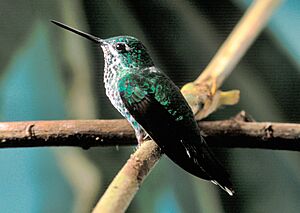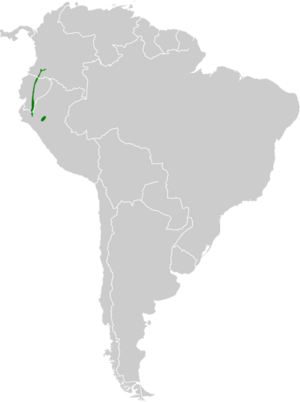Rufous-vented whitetip facts for kids
Quick facts for kids Rufous-vented whitetip |
|
|---|---|
 |
|
| Conservation status | |
| Scientific classification | |
| Genus: |
Urosticte
|
| Species: |
ruficrissa
|
 |
|
The rufous-vented whitetip (Urosticte ruficrissa) is a beautiful type of hummingbird. These tiny, colorful birds are known for their fast wings. You can find this hummingbird living in the countries of Colombia, Ecuador, and Peru in South America.
Contents
About the Rufous-Vented Whitetip
This hummingbird belongs to a group called "brilliants." It is closely related to another bird, the purple-bibbed whitetip. For a while, scientists debated if they were the same species. Now, most agree they are two different types of hummingbirds. These two birds are the only ones in their special bird family, called a genus.
What Does It Look Like?
The rufous-vented whitetip is a small bird, about 9 to 10 centimeters (3.5 to 4 inches) long. It weighs only about 4 to 4.2 grams (0.14 to 0.15 ounces). Both male and female birds have a straight, black beak that is not too long. They also have a clear white stripe right behind their eye.
Their top feathers are a shiny green color. They have a tail that splits at the end, like a fork. The male's tail is more deeply split than the female's.
Male and Female Differences
Male rufous-vented whitetips have shiny green feathers on their underside. Their tail feathers are a dark bronze color. The feathers in the middle of their tail have wide white tips.
Female birds have white feathers on their underside. These white feathers have green spots. Their tail feathers are also dark bronze, but only the outer feathers have white tips. Young birds look a lot like the females. They might also have brown edges on the feathers on their head.
Where Do They Live?
The rufous-vented whitetip lives on the eastern side of the Andes Mountains. You can find them from the Huila and Nariño areas of Colombia. They live south through eastern Ecuador and into the San Martín area of Peru.
These hummingbirds prefer to live inside or at the edges of forests. They like montane forests and cloudforests. These are forests found high up in the mountains. They usually live at heights between 1,600 and 2,400 meters (5,200 and 7,900 feet) above sea level.
How They Behave
Movement
Rufous-vented whitetips usually stay in one place. They do not travel far. However, after they have their babies, they might move to slightly higher places in the mountains.
What They Eat
These hummingbirds mostly look for food from near the ground up to the middle part of the forest. They drink nectar from many different kinds of flowers. This includes plants like bromeliads and others from the Clusia and Palicourea families.
Besides nectar, they also eat insects. They catch insects by flying out from a perch, which is called "hawking." Sometimes, they also pick insects off plants.
Reproduction
The rufous-vented whitetip's breeding season is from January to April. The female bird builds a cup-shaped nest using moss. She usually places her nest in vines. These nests are often about 2 to 4 meters (6.5 to 13 feet) above the ground.
The female lays two eggs. She sits on the eggs to keep them warm for 15 to 18 days. This is called incubation. The baby birds leave the nest about 22 to 24 days after they hatch.
Sounds They Make
The rufous-vented whitetip makes a soft, fast chirping sound. It can sound like "tweetweetweetwee..." or even like a "laughing chatter." When they are flying and eating, they also make a single, lower-pitched scratchy sound, like "tzrrrrr."
Their Status in Nature
The IUCN (International Union for Conservation of Nature) says the rufous-vented whitetip is a species of "Least Concern." This means they are not currently in danger of disappearing. However, scientists do not know exactly how many of these birds there are. They believe the number of birds might be going down.
Right now, there are no big threats that have been found for them. They are not very common in the areas where they live. Some of their homes are protected areas in Colombia. But in Ecuador, the cloudforests where they live are being cut down a lot.


